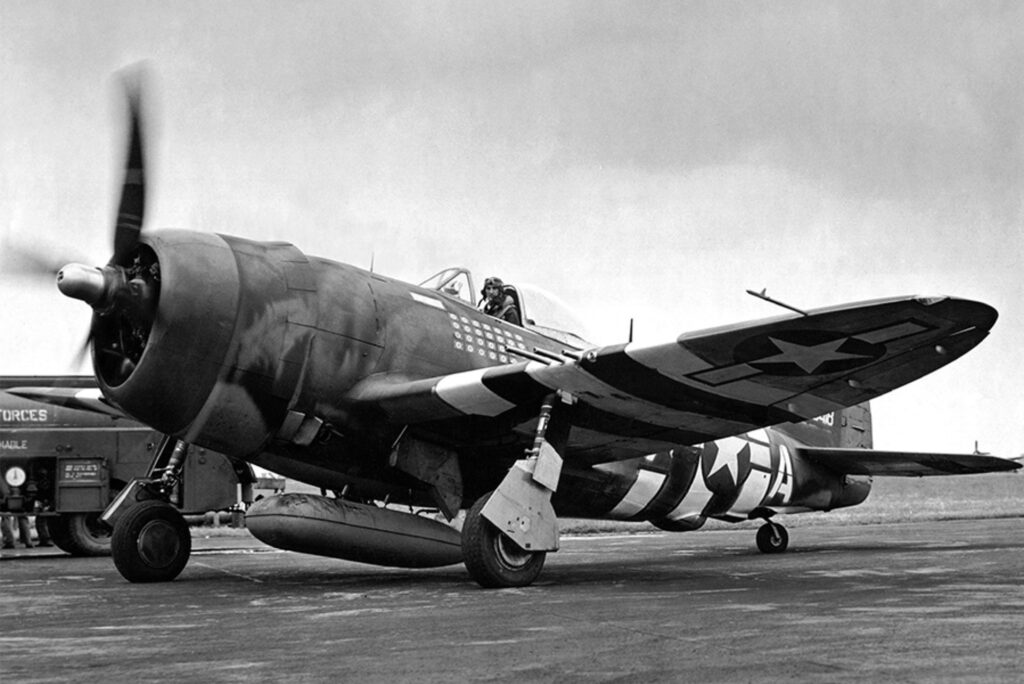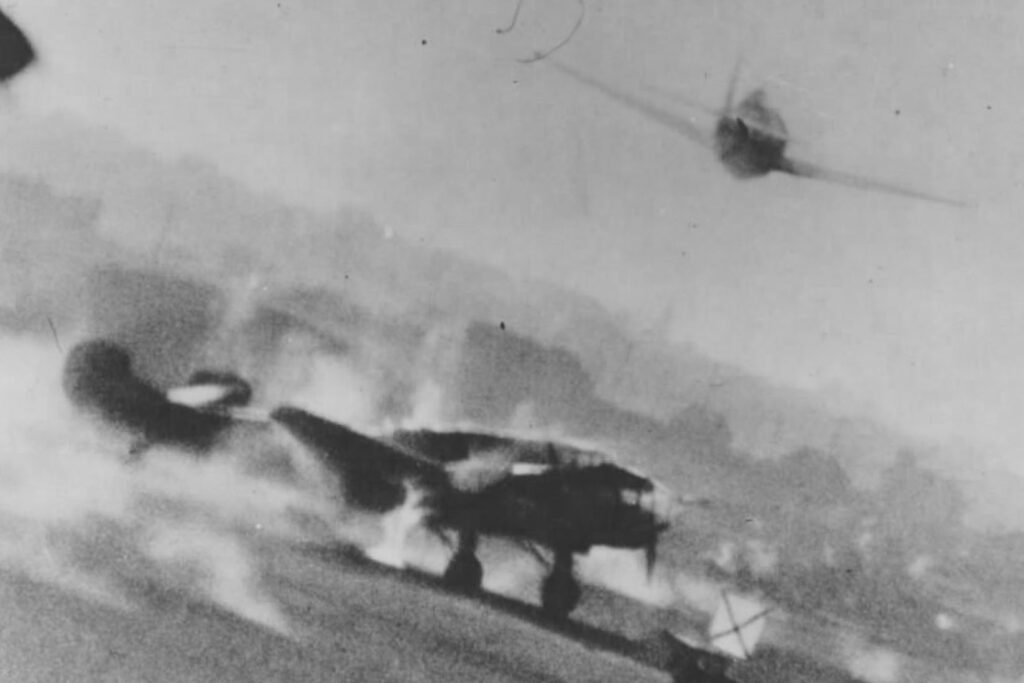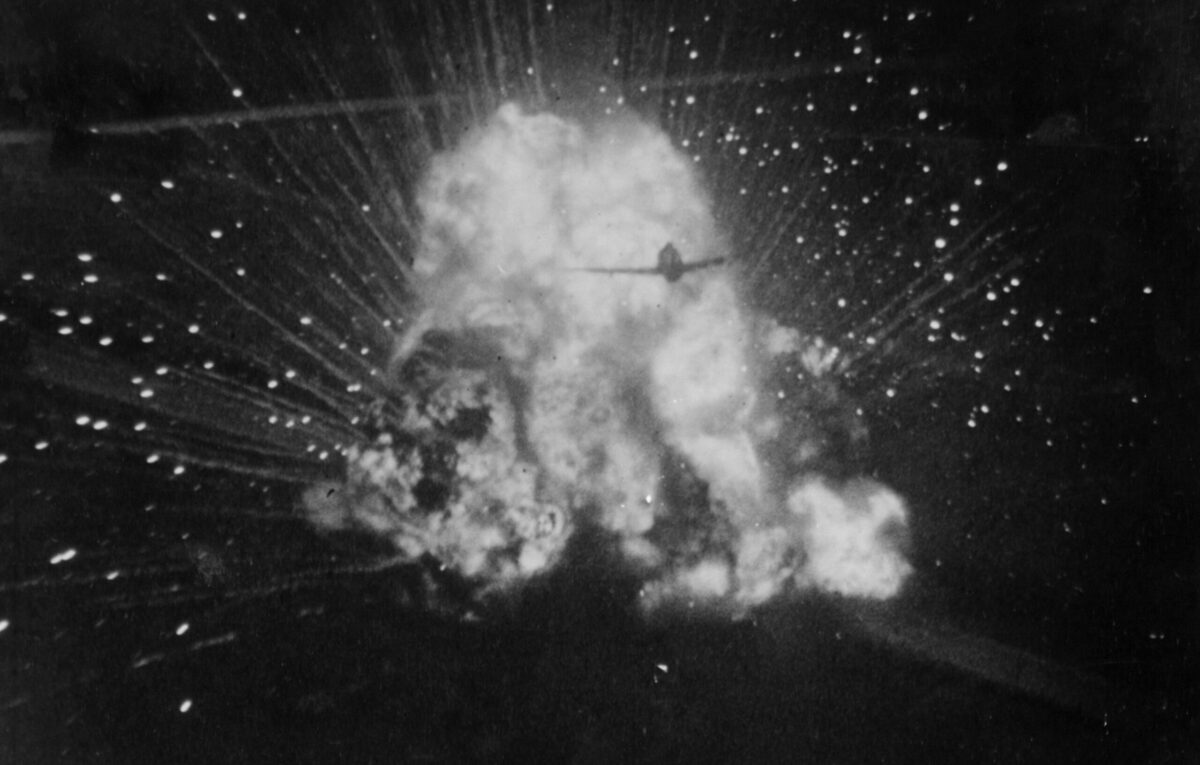On the afternoon of June 5, 1944, “Hub” Zemke returned to Boxted from a rodeo over Calais, only to receive orders to proceed immediately by car to Headquarters, Eighth Air Force Fighter Command (code-named “Ajax”). It was his second such trip in a week; the previous time he had been treated to a dinner with other puzzled group commanders and sent home again. That had apparently been a dry run; this time Zemke and his fellow commanders received a thorough briefing on the crucial operation scheduled the next day–D-Day, when the Allies would invade German-occupied France.
Actually, like the rest of the Eighth and Ninth air forces, the 56th had been softening up Northwest Europe for months in preparation for the landings. Allied Supreme Commander General Dwight D. “Ike” Eisenhower wanted all Luftwaffe aircraft destroyed and the Germans’ lines of communication and transportation cut before his men hit the beaches. The best tool the Americans had for that job was the P-47 Thunderbolt.
Although the North American P-51 Mustang ultimately got the glory as the premier American fighter of the war, with its delicate, belly-mounted radiator it was vulnerable to groundfire and unsuited for low-level strike missions. But the P-47’s massive air-cooled radial engine could shrug off considerable abuse, and the “Jug,” although originally designed as a high-altitude interceptor, made a formidable ground-attack machine.

In ground attack, as in air combat, the P-47’s great strength was its truly fearsome rate of dive. Plunging from 15,000 feet, with weapon release some 5,000 feet below that, Jug pilots avoided the worst of the flak and retained plenty of room to pull out–never an easy task in the Thunderbolt.
But if the P-47 could be made to pull out at zero altitude, it retained such speed it could be over a target and gone again before the enemy could fully react. (Wolfpack planes flew so low they often returned to Boxted with tree damage; Zemke himself once came back with a telelphone line wrapped around his prop.) In that manner, the Wolfpack ran rough shod over enemy airfields. The Eighth Air Force gave equal value–and equal credit–for German planes destroyed on the ground as for those blown out of the air (45 percent of the total Eighth Air Force fighter claims were for ground kills). On April 15, the group actually scored more ground kills than air kills, with Zemke himself destroying three Heinkel He-111 bombers parked at Flensburg Airdrome. By D-Day, Ike could confidently tell his troops: “Don’t worry about the planes overhead. They will be ours.”

By the time Zemke got back to Boxted from his D-Day eve briefing at Ajax it was nearly midnight. The 56th’s ground crews had already applied black and white “invasion stripes” to their red-nosed P-47s to protect them from friendly fire. Because ground commanders knew so much about the invasion plans, it was felt that they should not be allowed to fly to the briefing–the risk that they might go down over the continent was too great. The commanders had all driven to Ajax instead of flying, and Zemke stayed behind while Gabreski led the first mission aloft at 3:30 a.m. “The water was literally covered with ships between England and France,” recalled Gabreski. “It was one of the most spectacular sights I have ever seen, a massive demonstration of power.”
But after all the buildup, D-Day itself was to prove almost anticlimactic for the 56th Fighter Group. True to Ike’s prediction, the Luftwaffe avoided combat, and the Wolfpack, tasked with maintaining standing, squadron-strength patrols between Boulogne and the Seine, soon turned to providing ground support. Pilots ate and slept in the squadron ready rooms at Boxted between missions. With the invasion forces ashore, Zemke, who had caught a few hours of sleep that morning, led the day’s last mission. The Wolfpack joined P-51s of the 352nd Fighter Group in strafing a truck convoy, in the course of which they were jumped by four Focke-Wulfs. The Germans traded two Mustangs and a Thunderbolt for two of their own, including one to Zemke, who later recalled: “As I came in behind him he tightened his turn, suddenly losing control and spinning down straight into the ground. I never fired a shot.”

When the Allies began to push inland, they had fighter cover on call. Orbiting at 3,500 feet, Thunderbolts swooped down to rake German trucks, trains and troops columns with their eight .50-caliber Brownings. A three-second burst put 23 pounds of bullets into the target–75 two-ounce slugs, lethal from four miles away. Sheer recoil typically slowed the Jug 20 to 30 mph. For heavier game–the Panther, Tiger and King Tiger tanks infesting the hedgerow country–there were underwing bazookas and rail-launched 5-inch rockets.
Without control of the air, German troops were not free to move on the ground; photos taken in France in the summer of 1944 show them anxiously scanning the skies for attackers. For citizens of Germany, the drone of heavy bombers over their cities was a terrifying sound, but for Wehrmacht troops opposing the D-Day landings and subsequent invasion it was the roar of Allied fighters like the P-47 Thunderbolt–coming in at treetop level with guns and rockets ablaze–that struck fear in their hearts.





